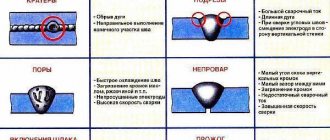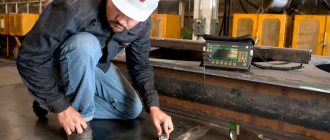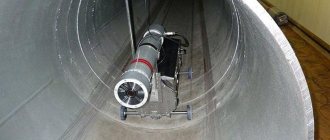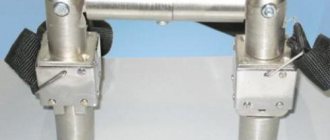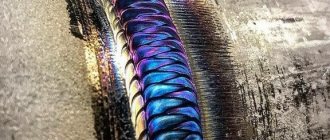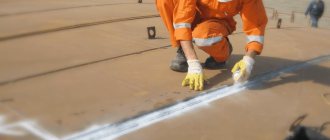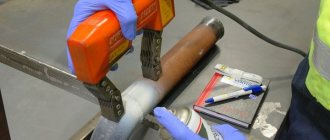Ultrasonic weld inspection has been successfully used to identify flaws in welded joints since the 1930s. Over such a long period of time, scientists together with practicing specialists have developed various echolocation techniques. With their help, it is easy to identify violations in the integrity of the diffuse layer, deviations in the chemical composition of the surfacing, detection of slag, and oxide impurities. Ultrasound diagnostics (USD) is not inferior in accuracy to X-rays or radar. The device detects even the smallest defects that negatively affect the strength of the joint.
Among the non-destructive methods used today for determining weld defects, ultrasonic scanning has become the most effective and one of the most accessible that are put on stream. Based on the results of the inspection, a special log is kept for each welder. The scope of application of ultrasonic testing is limited exclusively to the geometric data of the workpieces. Welding seams of pipelines that experience high pressure are subject to diagnostics.
How is ultrasonic testing carried out?
The method is more often used to control the strength of welds. An ultrasonic weld flaw detector operates on the following principle. Certain deformations, called acoustic or elastic waves, propagate into the thickness of the metal. They come in several types:
- infrasound;
- sound;
- ultrasonic;
- hypersonic.
During the propagation of ultrasound, the medium through which it diverges performs measured oscillations relative to the equilibrium point. Longitudinal and transverse vibrations can act in solid bodies. Both types of waves allow you to control the strength of welds as accurately as possible. The speed of delivery and propagation of ultrasound directly depends on the strength and internal environment of the material under study. The intensity of the sound waves can be controlled.
As the sound wave travels, its intensity subsides. The density of the material can be judged from the rate at which this occurs. The device shows the ultrasonic attenuation coefficient, forming it based on their scattering and absorption indicators. The accuracy of the readings is high, which allows you to get a clear picture of the quality of welds, metal, and other solid materials.
Ultrasonic inspection of welds
The testing technology is regulated by GOST R 55724-2013. Controller operators are issued certificates. Before the test, they are given instructions on TB. You have to check connections located in hard-to-reach places. The device must be grounded. The results are assessed according to several criteria. The following data is entered into the ultrasonic quality control log:
- length of the controlled weld;
- description of the defect (width, height, shape);
- transmitted wave range.
For diagnostics, the area under study (the roller plus the area of thermal influence) is cleaned. For better ultrasound penetration, an oily film is created on the surface. The device is set up according to the standard. The search for a reflected or transmitted signal takes place at maximum amplitude. Depending on the importance of the connection, inspection is carried out in one or two passes.
How does an ultrasonic weld flaw detector work?
Science knows only a few ways to work with ultrasonic devices to control the density of welds and other metal compounds. Their differences are only in the method of assessing the information received. Any type of data assessment complies with the current GOST.
Essence of the method
Echo method (in some sources – echo-pulse). This is the most commonly used ultrasonic testing method and is most often used to inspect welds. The principle of the method is as follows: a sound wave passing through the controlled product is reflected from the surface of the defect (if there is one) or from the surface of the bottom (if there are no defects). If a defect is detected, the device records this with a signal on the display. To use this method, access from only one side is sufficient and in some cases there is no need to disassemble the equipment.
You can control welds without removing the reinforcement using inclined probes. To carry out the control, it will be necessary to clean the seam to a distance of 100 mm in both directions; the roughness should not exceed Ra 3.2. You will also need to apply a coupling fluid (gel, glycerin, mineral oil, etc.)
Echo-mirror method . To implement it, 2 probes are used, one is a transmitter that emits sound waves. The second is a receiver, a receiver of reflected waves from a defect or bottom surface. They are located on one side of the controlled part and move together.
This method is used to identify vertically located defects, most often lack of penetration, lack of fusion and cracks located at the root of the weld.
Delta method. The principle of the method is as follows: the emitter introduces sound waves into the product, which are scattered and transformed at the edges of the defect into a longitudinal wave, which is recorded by a longitudinal wave receiver. One-sided access is sufficient for control. This method is difficult to use due to the need for extremely precise adjustment of the flaw detector. There are also high demands on the competence of the flaw detector. This method is actively used where the presence of vertically oriented defects is expected.
The mirror shadow method is based on measuring the reduction in signal strength from a defect. During testing, the signal passes through the cross section of the object twice.
This method is often used in conjunction with the echo method for additional control.
Shadow (in some literature amplitude-shadow) - this method is based on reducing the amplitude of the sound wave after passing through the defect. It requires two-way access. The emitter is installed on one side, and the receiver on the other, and sound is performed. An important feature is that it is impossible to determine the depth of the defect. It is used to control sheet structures.
The reverb-through method is used for inspection in polymers, multilayer materials and composites. The sensors are located on one side of the test object; the sound wave transmitted through the body of the object makes several reflections from the bottom surfaces.
Acoustic emission method. This method is used where it is necessary to identify defects at an early stage of their formation. The method is based on the ability to study low-frequency sound waves during the occurrence of defects such as cracks and structural changes.
Many sensors are installed on the controlled products, which record these waves and transmit them to amplifiers. Next, the signal enters the information processing unit, in which extraneous noise is filtered out. The resulting value is displayed.
Below is a diagram of acoustic emission testing.
This method is most often used at chemical and petrochemical industry facilities: tanks, containers and pipelines.
Properties of ultrasonic wave
A sound wave as a type of mechanical vibration has the following properties:
- Period—(T)—the time during which one complete oscillation occurs.
- Wavelength – (λ) is the distance a wave travels in one oscillation.
- Purity (f) is an important characteristic that shows how many oscillations occur in 1 second.
- Amplitude (dB) is the maximum deviation of a wave from its equilibrium state.
Ultrasonic testing also takes into account the type of waves:
- longitudinal wave (tension/compression)
- transverse (shear)
- surface (Rayleigh wave)
- Head wave
- Lamb wave (in plates)
- Porchhammer waves (in rods)
Direction angles
When carrying out ultrasonic testing, PETs (piezoelectronic transducers) are used. They, in turn, differ in the angle of wave input into the controlled materials by:
- Direct.
- Inclined.
Direct —create and receive ultrasonic waves at right angles to the testing surface.
Oblique transducers - create and receive ultrasonic waves at various angles different from the normal to the surface. Most often in practice, probes are used with insertion angles of 50, 65 and 70 degrees.
What defects can be identified
During inspection, the following defects can be identified:
- Pores.
- Bundles.
- Slag and other inclusions.
- Lack of penetration.
- Lack of fusion of edges.
Only the main defects are listed. Using ultrasound, you can identify other discontinuities, as well as their location and size.
Ultrasound source
Despite the different methods of collecting analytical data, ultrasonic metal flaw detectors use a similar method of operation. The main part of the device is a plate made of quartz or titanium barium. The plate is located in a special probe (search head). The probe is slowly moved along the surface under study, recording the wave extinction coefficient. The wave is supplied due to the action of an electric current, as a result of which ultrasound beams are generated. Based on the data obtained, we can talk about the density of the connection, the presence of defects, cavities, cracks, and other unnecessary deformations.
Ultrasonic testing equipment: operating principle
Devices used for ultrasonic testing of pipes and metal structures operate on a similar principle. The main working element is a piezoelectric sensor plate made of barium titanite or quartz. The piezoelectric sensor is located in the probe - it is placed along the connections and smoothly moved in a reciprocating motion. While the probe is moving, a high-frequency current flows to the plate, which is why it emits ultrasonic vibrations perpendicular to its length.
The reflected waves are received by the same plate with a receiving probe. It converts the oscillations into alternating current, which immediately rejects the wave on the oscilloscope monitor. As a result, an intermediate peak appears. During ultrasound diagnostics, the sensor sends short alternating pulses of elastic vibrations with different durations, which are separated by pauses. Due to this, the presence and depth of the defect is determined.
Diagnostic stages
Before starting the study, it is necessary to clean the metal from corrosion, paint, and other foreign matter. There is no need to clean the entire surface. It is enough to maintain a gap of up to 70 centimeters. In this form, the material is already ready for diagnostics, but it would be better to additionally ensure ultrasound permeability. For these purposes, grease, oil, glycerin, and other liquids containing fatty inclusions are used.
Before starting work, an ultrasonic weld flaw detector must be configured to achieve specific goals. There are several options here:
Kerosene
This method can be described as the simplest and cheapest, but this does not reduce its effectiveness. It is carried out using this technology.
- Clean the joint of two metal blanks from dirt and rust on both sides of the seam.
- On one side, a chalk solution is applied to the seam (400 g per 1 liter of water). You must wait for the applied layer to dry.
- Kerosene is applied to the reverse side. It is necessary to moisten generously in several approaches for 15 minutes.
- Now you need to observe the side where the chalk solution was applied. If dark patterns (spots, lines) appear, it means there is a defect in the weld. These drawings will only expand over time. Here it is important to accurately determine where the kerosene comes out, so after the first application of it to the seam, you need to immediately carry out observation. By the way, dots and small spots will indicate the presence of fistulas, lines - the presence of cracks. This method is very effective for connecting connections, for example, pipe to pipe. It is less effective when welding overlapping metals.
How to achieve the most accurate research results?
To obtain more accurate data, it is necessary to move the flaw detector probe in a zigzag manner along the surface of the material being examined. In this case, it is advisable to rotate the probe at least 10-15% around the axis of the metal. If the device emits any uncharacteristic vibrations, it is necessary to turn the probe as far as possible in the indicated place so that it becomes possible to accurately determine the dislocation of a poor-quality connecting seam. The search continues until the location of the matter where the ultrasound peak is highest is determined.
It should be taken into account that the ultrasound diagnostic device may produce errors due to wave reflection from the seams. For this purpose, additional research methods are used. If several diagnostic methods lead to the same answer, you can record the defect by recording the coordinates of the flaw. Equipment manufacturers, based on the requirements and rules of GOST, recommend diagnosing the same object at least twice with different devices.
The data obtained during operation of the ultrasonic flaw detector is recorded in a special journal or table. This allows you not only to quickly eliminate a flaw in the connection, but also to speed up re-diagnosis, because potential problem areas are already known.
Ultrasonic testing devices
The scope of application of ultrasonic installations is quite extensive. Ultrasonic flaw detectors are capable of detecting structural inconsistencies in metal structures and non-metallic products. Their great advantage is that it is also possible to carry out examinations on geometrically different elements, circles, rhombuses, plates or other complex figures.
Ultrasonic testing equipment is used at the initial stage of construction, material manufacturing, during the installation process, during long-term operation of the element, etc.
Also, these devices are widely used because they belong to one of the non-destructive testing methods, that is, using any flaw detector, there is no risk of damage to both the internal and external structure of the material.
What does a flaw detector consist of?
In order to most accurately understand the principle of operation of ultrasonic testing, let’s look at what ultrasonic testing devices consist of:
- source of emission of ultrasonic waves;
- special receiving element for receiving waves;
- control sensor;
- panel for displaying research results.
To determine the distance to the defect, the time of wave propagation before the start of foreign readings on the receiver is measured, and in order to find out the exact magnitude of the violation, the amplitude of the reflected pulse is used.
Ultrasonic testing devices
At the moment, there are various types of flaw detectors and their modernization; in general, they can all be divided into two main groups: these are thickness gauges and, directly, flaw detectors that operate using acoustic vibrations. They use sound transducers and special cables. To create a favorable environment for the passage of waves, special gels are used during the examination, which are applied to the material of the product.
Eddy current flaw detector Vit-4
The most popular device in Russia for finding and determining the depth of cracks in metal.
The weight of such a product is no more than 500 grams, which allows it to be absolutely mobile.
The device is used on metal products with a minimum thickness of 2 mm.
This equipment comes with:
- Eddy current converter.
- Battery.
- Connecting cable.
- Headphones.
- Special instructions for correct use.
- Case for this equipment.
- Two control samples made of steel and aluminum with cracks to check suitability.
The approximate cost of the VIT-4 flaw detector is 50,000 rubles. with a shelf life of 3 years.
Ultrasonic flaw detector for inspection of welded joints "PELENG"
Equipment of this type is intended for examining elements for the presence of continuities, homogeneity, and defects in welds. It can determine at what depth the disturbance is located and its approximate size.
Device weight up to 1 kg. It can perform inspections on materials with thicknesses ranging from 2 mm to 1.5 m.
Ultrasonic testing devices for welds, type EPOCH
This is a modern device that combines the standard set of capabilities of an ultrasonic device with a phased array. Used to examine the condition of welds. The advantage of this equipment is that it can operate in a very wide temperature range, that is, it is possible to conduct an examination during the application of the seam and immediately after.
It also has simplified sensitivity calibration and focusing capabilities. It is possible to filter out noise, which increases the accuracy of the images.
Keeping up with the times, this device has a large amount of memory, this allows you to save pictures immediately in the device without printing them. The device is capable of transferring data directly to computer software without loss of image quality.
Device UD2-70
UD2-70 is one of the modifications of UD type devices. This ultrasonic testing equipment is almost universal, as it allows you to determine continuity, find cracks, and examine welds, small parts, and semi-finished products. This device is especially popular in the locomotive industry. UD devices have an interface for detecting defects in parts of wheel sets, wheel sets, etc.
The weight of this product, although greater than that of higher-level devices, is 2200 g, but it is still mobile and affordable. Possibility of taking pictures through thicknesses from 2 mm to 5 meters!
The body of the device is made of aluminum, which makes it especially reliable. The sensitivity of contrasts is high and there is also an internal built-in memory that allows you to save examination results.
Ultrasonic testing device for welded joints USD
Universal equipment, available on the market in various modifications. Made from impact resistant material.
The weight of the device is 1500 g. The devices of this series also have an input for an encoder, which allows you to easily and quickly connect scanners to create scans of the examination area.
Among the pleasant functions of this device, in addition to its reliability and good performance characteristics, is the function of changing the display color.
Ultrasonic flaw detectors for weld inspection "SKARUCH"
Suitable for materials with a thickness of 4 to 60 mm, there is a built-in thickness gauge function. It is used for examining welded joints and round-shaped structures (main pipelines, various vessels, etc.).
It is possible to connect to a computer to transfer information or connect to a printer to output information on paper.
The weight of the scanning unit is about 4 kg.
The device is certified and used in various industries and construction. It is a manual device without automatic data adjustment.
Ultrasound device DIO 1000 SFE
The equipment is equipped with the latest technology, modern functions for connecting a personal computer, printers and additional scanning units. It has a large screen, is compact and easy to use.
It is a high-frequency device and weighs only 1.3 kg!
For ease of use, the screen is equipped with an anti-glare function and is a fully digital device.
One of the highest operating temperature ranges from -20 to 60 degrees. Can operate on battery power for up to 10 hours.
Application of flaw detectors abroad
The first flaw detectors were of the lamp type, and they began to be produced in the mid-twentieth century.
In the rapid flow of technology development, flaw detectors are constantly changing, modernizing and improving. Abroad, a third of all inspections of structures and products are carried out by ultrasonic inspection using a non-destructive method.
Due to their small size and safety for the environment, devices for ultrasonic testing of welded joints are widely used at nuclear power plants, pipelines with flammable substances, etc., since it is difficult to use automatic testing devices at such enterprises.
Defects that are accurately detected by ultrasound diagnostics
Inspection of welding seams, carried out using ultrasonic devices, gives a clear picture of the situation. Correctly performed work with the device almost 100% guarantees the accuracy of answering questions. But, nevertheless, the scope of use of the equipment has some limitations.
Problems that can actually be detected by an ultrasound sensor:
Diagnostics is most accurate if applied to the following types of metal:
Sutures that can be examined using ultrasound can be:
Ultrasonic thickness gauges
Thickness gauges are ultrasonic flaw detection equipment used to measure the thickness of the top coating of a metal product in order to determine the integrity of the layer and the degree of its wear.
The thickness gauge works using ultrasonic vibrations, but is configured differently. After applying it to the coating, the waves penetrate the paint layer and rest on the metal surface underneath. Data on the time it takes for the layer to pass before it is reflected by the metal surface is read and the device gives an accurate thickness value.
Field of application of ultrasonic flaw detector
Such devices are in greatest demand in the manufacturing sector. The diagnostic service can also be ordered privately to control welding seams during the construction of buildings, reconstruction of residential and industrial premises. Seam inspection is indispensable when you need to determine the degree of wear of water and gas pipes. Owners of the oil, chemical and engineering industries are actively purchasing equipment. Portable ultrasonic flaw detectors are used by geologists in the field, as well as laboratory assistants to examine small objects.
The principle of ultrasonic testing, the production and properties of ultrasonic vibrations
One of the most common and most reliable inspection methods can be considered the ultrasonic flaw detection method. This method is based on the use of wave oscillation effect. When vibrations pass through any homogeneous medium, they do not deviate from the given trajectory, however, if along the path of the waves there are cracks, voids, slag inclusions, irregularities, structural inhomogeneities, etc., then all this will be reflected on the panel of the ultrasonic testing device - flaw detector. This ultrasonic testing equipment helps to examine the quality of installation of welded joints, the location of defects in joints and structures, the size of the defect, and sometimes it is possible to determine the type of defect by visible characteristics.
Application of ultrasonic flaw detection
- Incoming inspection of metal and plastic products.
- Determination of wear resistance of main pipelines, structures of the thermal, chemical and oil refining industries.
- Checking the condition of parts and elements at machine-building enterprises.
- Inspection of connections and welds of elements.
- Checking the quality and condition of various metal elements in laboratory and field conditions.
Ultrasonic flaw detector: price, delivery
The site presents the best models of devices. The range of prices and functionality will pleasantly surprise the company's clients. You can clarify the exact cost of a flaw detector by using the electronic communication form, indicating the exact model of the device. All models of diagnostic equipment are described in detail. Here visitors will learn information about the manufacturer, functionality, dimensions, and area of application of a particular flaw detector. Additional questions should be clarified with the consultant.
The price of any ultrasonic flaw detector also depends on the manufacturer. The entire range of the site is covered by a manufacturer's warranty. Targeted delivery to the regions is carried out. Free consultations are available to clients. Promotions and sales, information about which is regularly updated on the portal, will help you save.
Vector-50 (NPC "Kropus")
at a price of 280,000 rubles.
Vector-50 is a model of an eddy current flaw detector from a constantly updated line from the Kropus Research and Production Center. This is the largest Russian manufacturer of NDT equipment, so its products could not fail to be included in our review.
Model features
The device is universal, because Supports any eddy current and impedance converters. This makes it possible to assess the condition of metal, carbon fiber and composite products, to identify surface and subsurface cracks and discontinuities in them. The device can be used as a thickness gauge and to determine the electrical conductivity of non-ferrous metals.
In addition to its compact dimensions (200x225x80 mm) and low weight (1.5 kg), the equipment has a color display with a resolution of 640x480 pixels and connects to a computer via USB. The device memory can store 100 settings and 500 control protocols.
Among the features is the display of the signal on the display in two planes: complex and amplitude-time. Various signal visualization modes are available. There is also the possibility of separate amplification along the abscissa and ordinate axis. The device can be used with rotary transducers for hole inspection.
The flaw detector is powered from a 220V network or battery.
In the second case, the maximum battery life is 10 hours. Technical characteristics* Vector-50
| Parameter | Meaning |
| Operating mode | standard, synchronous, frequency scanning |
| Gain adjustment, dB | 0-70 in steps, 0.1, 1, 2, 6 or 10 |
| Frequency change, Hz | 1-20×106 in increments of 1, 10, 100 or 1000 |
| Low-pass/high-pass filter, Hz | 5-1000/2,5-500 |
| Types of suitable converters | rotary, absolute, differential |
| Operating temperature, °C | -30…+55 |
| Dimensions, mm | 200×225×80 |
| Weight, kg | 1,5 |
*See the full list on the official website.
See how this flaw detector works in tandem with a rotary sensor to detect surface cracks in bolted process holes:
Advantages and disadvantages
The popularity of ultrasonic flaw detection of welds is explained by the following advantages of this technique:
- high sensitivity of instruments that make it possible to accurately identify and describe the characteristics of identified deviations from welding technology;
- ease of use due to the compactness of the equipment used;
- minimal costs - flaw detectors are relatively inexpensive, in the absence of consumables for testing;
- maintaining the integrity of the connection during diagnostics;
- wide range of applications, with the ability to control the structure of metal over large thicknesses;
- the ability to check equipment without long-term decommissioning;
- safety for human health, which cannot be said about the radiographic method.
But don't forget about the shortcomings. Ultrasonic testing is difficult to use when the metal structure is coarse. Diagnostics requires preliminary preparation of the seam. The use of the technique is limited by certain tolerances on the geometric dimensions of the connection.
The testing laboratory "Micro" offers services for ultrasonic flaw detection of welded joints. The work is carried out by qualified experts using modern equipment, which guarantees complete reliability of the results.

